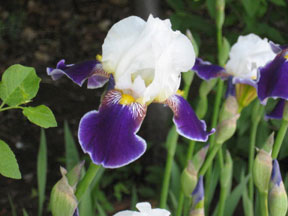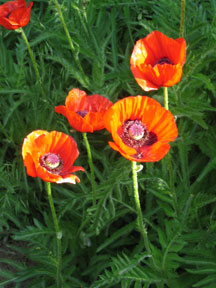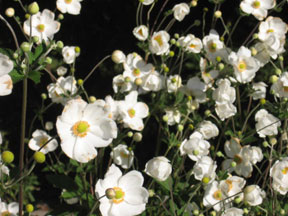By Jan Hale Barbo
September brings a respite from summer heat and long days. And it is often the time when our gardens tend to look tired and overgrown, beckoning us to begin the necessary and thorough campaign of focusing on the landscape and scrutinizing how various plants performed over the past few seasons. The goal always is to have the right plant in the right place at the right time.
Plants possess certain credentials that are designed to bring creativity to our gardening efforts, yet they hold no long-term rights to possession of a particular space. Destruction and renewal are built into the life of any garden as plants grow, self-sow and, alas, sometimes die. And while a plant’s credentials may remain the same, the changing situation in garden spaces often requires that we reassess its proper location in the garden.

Iris ‘Wabash’
So put away any thought that the end of the so-called growing season is the end of the gardening season. Just as cooler temperatures make working in the garden more pleasant for the gardener, the cool air and still-warm soil are beneficial to plants. In fact, as above-ground foliage growth slows, below-ground root growth swells.
Perennials “sleep” the first year after planting as they establish roots; they “creep” the second year by showing modest growth and producing flowers; and they “leap” the third year by putting on a brilliant show of foliage and flowers. Most then begin to decline in vigor and greatly benefit from division. Replanting or sharing divisions with friends begins the process all over again.
To provide plants every opportunity to become established before winter sets in, divisions should be in the ground before leaves have fallen from deciduous trees, such as the cottonwood. Plants that have not had time to develop strong roots by the end of autumn probably won’t survive the winter.
When dividing plants, a four-tined garden fork is less likely than the blade of a shovel to slice into and damage roots. Dig the entire plant and shake loose soil away, then tease the roots apart, or use a strong stream of water to separate the roots by washing soil away. Before replanting, cut foliage back by at least half to compensate for any loss of roots. Replant the division at the same depth it was previously growing.

Papaver orientale
Whether plants survive division depends not so much on how they were separated as it does on how they were handled afterwards. When a plant is dug and transplanted, it loses many of its roots and must grow new ones in its new home. Vast numbers of plants die or suffer severely injured root zones when they are left to languish for days, even weeks, because the gardener wasn’t prepared to complete the project.
Irises, for instance, seem to frequently suffer from the illusion that nothing can kill them. Even though their thick rhizomes are tough, they do lose moisture and begin to die, however slowly. Their rhizomes cannot form buds to produce flowers until they are planted in soil, receiving water and nutrients, and a delay in planting may result in a year’s delay in flowering.
And the fine, hair-like roots found on many perennials begin to die within fifteen minutes of digging if allowed to dry out. However, just as we don’t soak our feet for hours or days on end, plant roots should not be left to soak in a bucket of water longer than an hour or so.

Anemone 'Honorine Jobert'
Neglecting to water newly planted divisions is another sure route to failure. Apply water deeply to settle the soil around the roots and eliminate any air pockets. Keep the drip system on, or several lengths of garden hose handy, in case our drought persists into the fall and winter months. Continue to water weekly until mid-November and monthly thereafter until the ground freezes.
Irises, Oriental poppies and peonies require early fall planting; the phloxes and most other perennials, such as Japanese anemones, certainly prefer it. Exceptions include lavenders and ornamental grasses.
Deadheading (removing spent blossoms) should be stopped now, allowing plants to head toward dormancy and the garden to go to seed. Rather than trim purple coneflowers into boring stubs, consider the possibility of watching small birds light upon the blackened cones for a ready meal on cold wintry days. These seed heads and others will shape and enliven the garden well into winter, serving as stately receptacles for early snowfalls. When generous germination occurs next spring, excess plants can be easily removed or transplanted.
Scrutinize garden spaces now to choose sites where bountiful bulbs would provide early rounds of color for springtime cheer, but wait until the soil has cooled in October before planting them in full or partial sun.


